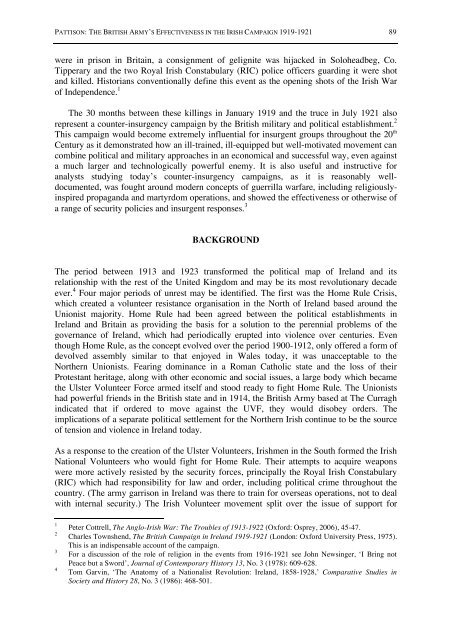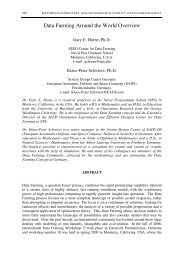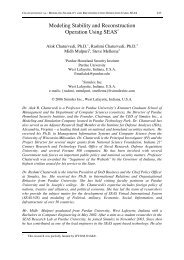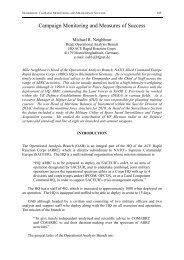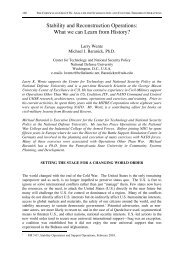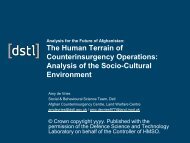The British Army's Effectiveness in the Irish ... - Cornwallis Group
The British Army's Effectiveness in the Irish ... - Cornwallis Group
The British Army's Effectiveness in the Irish ... - Cornwallis Group
Create successful ePaper yourself
Turn your PDF publications into a flip-book with our unique Google optimized e-Paper software.
PATTISON: THE BRITISH ARMY’S EFFECTIVENESS IN THE IRISH CAMPAIGN 1919-1921 89<br />
were <strong>in</strong> prison <strong>in</strong> Brita<strong>in</strong>, a consignment of gelignite was hijacked <strong>in</strong> Soloheadbeg, Co.<br />
Tipperary and <strong>the</strong> two Royal <strong>Irish</strong> Constabulary (RIC) police officers guard<strong>in</strong>g it were shot<br />
and killed. Historians conventionally def<strong>in</strong>e this event as <strong>the</strong> open<strong>in</strong>g shots of <strong>the</strong> <strong>Irish</strong> War<br />
of Independence. 1<br />
<strong>The</strong> 30 months between <strong>the</strong>se kill<strong>in</strong>gs <strong>in</strong> January 1919 and <strong>the</strong> truce <strong>in</strong> July 1921 also<br />
represent a counter-<strong>in</strong>surgency campaign by <strong>the</strong> <strong>British</strong> military and political establishment. 2<br />
This campaign would become extremely <strong>in</strong>fluential for <strong>in</strong>surgent groups throughout <strong>the</strong> 20 th<br />
Century as it demonstrated how an ill-tra<strong>in</strong>ed, ill-equipped but well-motivated movement can<br />
comb<strong>in</strong>e political and military approaches <strong>in</strong> an economical and successful way, even aga<strong>in</strong>st<br />
a much larger and technologically powerful enemy. It is also useful and <strong>in</strong>structive for<br />
analysts study<strong>in</strong>g today’s counter-<strong>in</strong>surgency campaigns, as it is reasonably welldocumented,<br />
was fought around modern concepts of guerrilla warfare, <strong>in</strong>clud<strong>in</strong>g religiously<strong>in</strong>spired<br />
propaganda and martyrdom operations, and showed <strong>the</strong> effectiveness or o<strong>the</strong>rwise of<br />
a range of security policies and <strong>in</strong>surgent responses. 3<br />
BACKGROUND<br />
<strong>The</strong> period between 1913 and 1923 transformed <strong>the</strong> political map of Ireland and its<br />
relationship with <strong>the</strong> rest of <strong>the</strong> United K<strong>in</strong>gdom and may be its most revolutionary decade<br />
ever. 4 Four major periods of unrest may be identified. <strong>The</strong> first was <strong>the</strong> Home Rule Crisis,<br />
which created a volunteer resistance organisation <strong>in</strong> <strong>the</strong> North of Ireland based around <strong>the</strong><br />
Unionist majority. Home Rule had been agreed between <strong>the</strong> political establishments <strong>in</strong><br />
Ireland and Brita<strong>in</strong> as provid<strong>in</strong>g <strong>the</strong> basis for a solution to <strong>the</strong> perennial problems of <strong>the</strong><br />
governance of Ireland, which had periodically erupted <strong>in</strong>to violence over centuries. Even<br />
though Home Rule, as <strong>the</strong> concept evolved over <strong>the</strong> period 1900-1912, only offered a form of<br />
devolved assembly similar to that enjoyed <strong>in</strong> Wales today, it was unacceptable to <strong>the</strong><br />
Nor<strong>the</strong>rn Unionists. Fear<strong>in</strong>g dom<strong>in</strong>ance <strong>in</strong> a Roman Catholic state and <strong>the</strong> loss of <strong>the</strong>ir<br />
Protestant heritage, along with o<strong>the</strong>r economic and social issues, a large body which became<br />
<strong>the</strong> Ulster Volunteer Force armed itself and stood ready to fight Home Rule. <strong>The</strong> Unionists<br />
had powerful friends <strong>in</strong> <strong>the</strong> <strong>British</strong> state and <strong>in</strong> 1914, <strong>the</strong> <strong>British</strong> Army based at <strong>The</strong> Curragh<br />
<strong>in</strong>dicated that if ordered to move aga<strong>in</strong>st <strong>the</strong> UVF, <strong>the</strong>y would disobey orders. <strong>The</strong><br />
implications of a separate political settlement for <strong>the</strong> Nor<strong>the</strong>rn <strong>Irish</strong> cont<strong>in</strong>ue to be <strong>the</strong> source<br />
of tension and violence <strong>in</strong> Ireland today.<br />
As a response to <strong>the</strong> creation of <strong>the</strong> Ulster Volunteers, <strong>Irish</strong>men <strong>in</strong> <strong>the</strong> South formed <strong>the</strong> <strong>Irish</strong><br />
National Volunteers who would fight for Home Rule. <strong>The</strong>ir attempts to acquire weapons<br />
were more actively resisted by <strong>the</strong> security forces, pr<strong>in</strong>cipally <strong>the</strong> Royal <strong>Irish</strong> Constabulary<br />
(RIC) which had responsibility for law and order, <strong>in</strong>clud<strong>in</strong>g political crime throughout <strong>the</strong><br />
country. (<strong>The</strong> army garrison <strong>in</strong> Ireland was <strong>the</strong>re to tra<strong>in</strong> for overseas operations, not to deal<br />
with <strong>in</strong>ternal security.) <strong>The</strong> <strong>Irish</strong> Volunteer movement split over <strong>the</strong> issue of support for<br />
1 Peter Cottrell, <strong>The</strong> Anglo-<strong>Irish</strong> War: <strong>The</strong> Troubles of 1913-1922 (Oxford: Osprey, 2006), 45-47.<br />
2 Charles Townshend, <strong>The</strong> <strong>British</strong> Campaign <strong>in</strong> Ireland 1919-1921 (London: Oxford University Press, 1975).<br />
This is an <strong>in</strong>dispensable account of <strong>the</strong> campaign.<br />
3 For a discussion of <strong>the</strong> role of religion <strong>in</strong> <strong>the</strong> events from 1916-1921 see John News<strong>in</strong>ger, ‘I Br<strong>in</strong>g not<br />
Peace but a Sword’, Journal of Contemporary History 13, No. 3 (1978): 609-628.<br />
4 Tom Garv<strong>in</strong>, ‘<strong>The</strong> Anatomy of a Nationalist Revolution: Ireland, 1858-1928,’ Comparative Studies <strong>in</strong><br />
Society and History 28, No. 3 (1986): 468-501.


